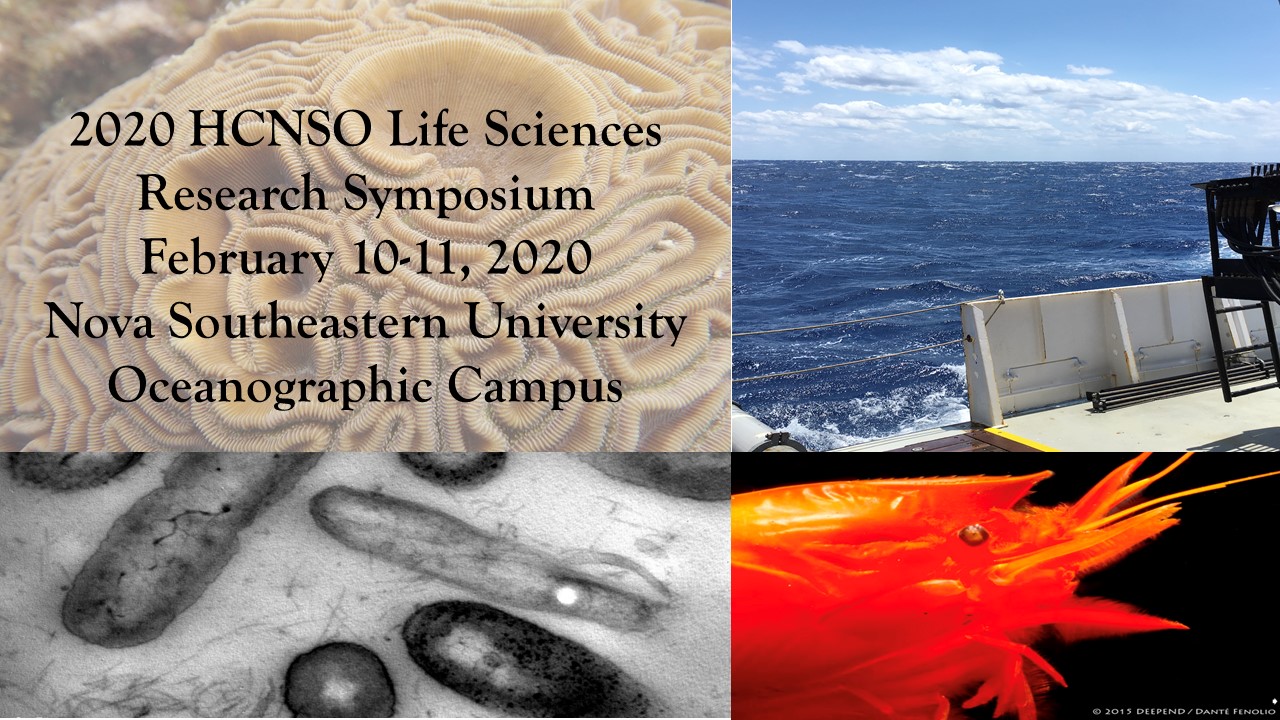Ectosymbiotic microbiomes of parasitic nematodes (Ozolaimus megatyphon) and their iguana hosts
Location
HCNSO Guy Harvey Oceanographic Center Nova Southeastern University
Start
2-11-2020 9:00 AM
End
2-11-2020 9:15 AM
Type of Presentation
Oral Presentation
Abstract
Florida iguanas (Iguana iguana, Ctenosaura similis) are heavily infected with Ozolaimus megatyphon, a parasitic nematode worm. Prior work in our lab noted an apparent microbial community associated with the worm cuticle. Observations of parasite microbiomes are scarce: ours was the first description of a putative cuticular microbiome associated with this species, and to our knowledge the first non-anecdotal observation of ectosymbionts on a parasitic nematode. The objective of this project was to characterize the cuticular microbiome of O. megatyphon and compare it with the gut microbiome of its host, using a combination of morphological observations and molecular analysis. Morphological examination via light microscopy of worm cuticle stained with gram, Periodic Acid Schiff, lactophenol and methylene blue stains indicated that the community was exclusively bacterial. Further observations using Scanning Electron Microscopy (SEM) revealed the presence of a diverse community of coccoid and coliform bacteria associated with dense mats of possible segmented filamentous bacteria embedded in the worm cuticle; we did not observe similar communities associated with host gut lining or partially digested food. We then conducted molecular analyses on this microbiome, amplifying and sequencing the variable regions of 16S rRNA using PCR (primer 319F/806R) and Illumina cBot to generate clusters for sequencing on MiSeq. This approach allowed for metabarcoding and molecular level characterization of both parasite and host bacterial communities. These differed in both species composition and community structure. For example, nematode microbiomes were dominated by Lachnospiraceae, Clostridium, and Bacteroidetes, whereas the host gut featured a more diverse and even community of taxa typical of plant-eating vertebrates. Our results offer interesting insights into this host-parasite system. For example, the presence of cellulose-fermenting bacteria on nematode cuticles may indirectly benefit the host; this raises the possibility that the O. megatyphon – iguana relationship may be at least partially mutualistic, rather than strictly parasitic.
Ectosymbiotic microbiomes of parasitic nematodes (Ozolaimus megatyphon) and their iguana hosts
HCNSO Guy Harvey Oceanographic Center Nova Southeastern University
Florida iguanas (Iguana iguana, Ctenosaura similis) are heavily infected with Ozolaimus megatyphon, a parasitic nematode worm. Prior work in our lab noted an apparent microbial community associated with the worm cuticle. Observations of parasite microbiomes are scarce: ours was the first description of a putative cuticular microbiome associated with this species, and to our knowledge the first non-anecdotal observation of ectosymbionts on a parasitic nematode. The objective of this project was to characterize the cuticular microbiome of O. megatyphon and compare it with the gut microbiome of its host, using a combination of morphological observations and molecular analysis. Morphological examination via light microscopy of worm cuticle stained with gram, Periodic Acid Schiff, lactophenol and methylene blue stains indicated that the community was exclusively bacterial. Further observations using Scanning Electron Microscopy (SEM) revealed the presence of a diverse community of coccoid and coliform bacteria associated with dense mats of possible segmented filamentous bacteria embedded in the worm cuticle; we did not observe similar communities associated with host gut lining or partially digested food. We then conducted molecular analyses on this microbiome, amplifying and sequencing the variable regions of 16S rRNA using PCR (primer 319F/806R) and Illumina cBot to generate clusters for sequencing on MiSeq. This approach allowed for metabarcoding and molecular level characterization of both parasite and host bacterial communities. These differed in both species composition and community structure. For example, nematode microbiomes were dominated by Lachnospiraceae, Clostridium, and Bacteroidetes, whereas the host gut featured a more diverse and even community of taxa typical of plant-eating vertebrates. Our results offer interesting insights into this host-parasite system. For example, the presence of cellulose-fermenting bacteria on nematode cuticles may indirectly benefit the host; this raises the possibility that the O. megatyphon – iguana relationship may be at least partially mutualistic, rather than strictly parasitic.


